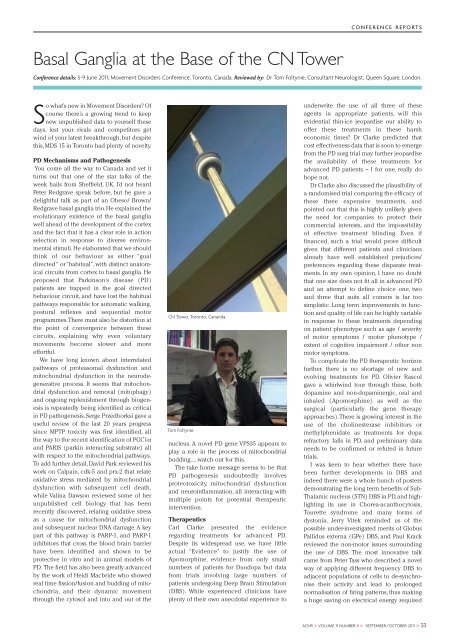Create successful ePaper yourself
Turn your PDF publications into a flip-book with our unique Google optimized e-Paper software.
CONFERENCE REPORTSBasal Ganglia at the Base of the CN TowerConference details: 5-9 June 2011; Movement Disorders Conference, Toronto, Canada. Reviewed by: Dr Tom Foltynie, Consultant Neurologist, Queen Square, London.So what’s new in Movement Disorders? Ofcourse there’s a growing trend to keepnew unpublished data to yourself thesedays, lest your rivals and competitors getwind of your latest breakthrough, but despitethis, MDS 15 in Toronto had plenty of novelty.PD Mechanisms and PathogenesisYou come all the way to Canada and yet itturns out that one of the star talks of theweek hails from Sheffield, UK. I’d not heardPeter Redgrave speak before, but he gave adelightful talk as part of an Obeso/ Brown/Redgrave basal ganglia trio. He explained theevolutionary existence of the basal gangliawell ahead of the development of the cortexand the fact that it has a clear role in actionselection in response to diverse environmentalstimuli. He elaborated that we shouldthink of our behaviour as either “goaldirected “ or “habitual”, with distinct anatomicalcircuits from cortex to basal ganglia. Heproposed that Parkinson’s disease (PD)patients are trapped in the goal directedbehaviour circuit, and have lost the habitualpathways responsible for automatic walking,postural reflexes and sequential motorprogrammes. There must also be distortion atthe point of convergence between thesecircuits, explaining why even voluntarymovements become slower and moreeffortful.We have long known about interrelatedpathways of proteasomal dysfunction andmitochondrial dysfunction in the neurodegenerativeprocess. It seems that mitochondrialdysfunction and removal (mitophagy)and ongoing replenishment through biogenesisis repeatedly being identified as criticalin PD pathogenesis. Serge Przedborksi gave auseful review of the last 20 years progresssince MPTP toxicity was first identified, allthe way to the recent identification of PGC1αand PARIS (parkin interacting substrate) allwith respect to the mitochondrial pathways.To add further detail, David Park reviewed hiswork on Calpain, cdk-5 and prx-2 that relateoxidative stress mediated by mitochondrialdysfunction with subsequent cell death,while Valina Dawson reviewed some of herunpublished cell biology that has beenrecently discovered, relating oxidative stressas a cause for mitochondrial dysfunctionand subsequent nuclear DNA damage. A keypart of this pathway is PARP-1, and PARP-1inhibitors that cross the blood brain barrierhave been identified and shown to beprotective in vitro and in animal models ofPD. The field has also been greatly advancedby the work of Heidi Macbride who showedreal time fission/fusion and budding of mitochondria,and their dynamic movementthrough the cytosol and into and out of theCN Tower, Toronto, Cananda.Tom Foltynie.nucleus. A novel PD gene VPS35 appears toplay a role in the process of mitochondrialbudding.... watch out for this.The take home message seems to be thatPD pathogenesis undoubtedly involvesproteotoxicity, mitochondrial dysfunctionand neuroinflammation, all interacting withmultiple points for potential therapeuticintervention.TherapeuticsCarl Clarke presented the evidenceregarding treatments for advanced PD.Despite its widespread use, we have littleactual “Evidence” to justify the use ofApomorphine, evidence from only smallnumbers of patients for Duodopa but datafrom trials involving large numbers ofpatients undergoing Deep Brain Stimulation(DBS). While experienced clinicians haveplenty of their own anecdotal experience tounderwrite the use of all three of theseagents in appropriate patients, will thisevidential thin-ice jeopardise our ability tooffer these treatments in these harsheconomic times? Dr Clarke predicted thatcost effectiveness data that is soon to emergefrom the PD surg trial may further jeopardisethe availability of these treatments foradvanced PD patients – I for one, really dohope not.Dr Clarke also discussed the plausibility ofa randomised trial comparing the efficacy ofthese three expensive treatments, andpointed out that this is highly unlikely giventhe need for companies to protect theircommercial interests, and the impossibilityof effective treatment blinding. Even iffinanced, such a trial would prove difficultgiven that different patients and cliniciansalready have well established prejudices/preferences regarding these disparate treatments.In my own opinion, I have no doubtthat one size does not fit all in advanced PDand an attempt to define choice one, twoand three that suits all comers is far toosimplistic. Long term improvements in functionand quality of life can be highly variablein response to these treatments dependingon patient phenotype such as age / severityof motor symptoms / motor phenotype /extent of cognitive impairment / other nonmotor symptoms.To complicate the PD therapeutic horizonfurther, there is no shortage of new andevolving treatments for PD. Olivier Rascolgave a whirlwind tour through these, bothdopamine and non-dopaminergic, oral andinhaled (Apomorphine) as well as thesurgical (particularly the gene therapyapproaches). There is growing interest in theuse of the cholinesterase inhibitors ormethylphenidate as treatments for doparefractory falls in PD, and preliminary dataneeds to be confirmed or refuted in futuretrials.I was keen to hear whether there havebeen further developments in DBS andindeed there were a whole bunch of postersdemonstrating the long term benefits of Sub-Thalamic nucleus (STN) DBS in PD, and highlightingits use in Chorea-acanthocytosis,Tourette syndrome and many forms ofdystonia. Jerry Vitek reminded us of thepossible under-investigated merits of GlobusPallidus externa (GPe) DBS, and Paul Krackreviewed the non-motor issues surroundingthe use of DBS. The most innovative talkcame from Peter Tass who described a novelway of applying different frequency DBS toadjacent populations of cells to de-synchronisetheir activity and lead to prolongednormalisation of firing patterns, thus makinga huge saving on electrical energy required<strong>ACNR</strong> > VOLUME 11 NUMBER 4 > SEPTEMBER/OCTOBER 2011 > 33

















